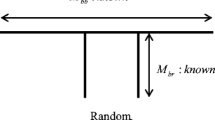Abstract
Investigation of the extensional flow behavior and development of constitutive equations for well-characterized H-shaped polymers is important both from an industrial and academic viewpoints. For H-shaped polymer systems, little is known about the extensional flow behavior at constant strain rates. We synthesized H-shaped poly(methyl methacrylate)s (PMMAs) with narrow molecular weight distributions and various ratios of the molecular weight of the backbone, M b, to that of the arm, M a, by atom transfer radical polymerization. However, 1H NMR spectroscopy showed that the resulting PMMA samples contained substantial amounts of linear and star topologies. In spite of the limited purity of the H-shaped PMMAs obtained, the rheological properties in linear viscoelasticity and uniaxial extensional flow revealed interesting results. The zero-shear viscosity of model PMMAs was well described by an exponential relation of the molecular weight. Qualitative agreement was found between the experimental linear-viscoelastic behavior and predictions of the model of McLeish et al. (Macromolecules 32: 6734–6758, 1999) for H-shaped polymers. The elongational flow behavior was also analyzed by the molecular stress function (MSF) model. Surprisingly, the strain-hardening effect for all investigated model PMMAs was weaker than that for pom-pom polystyrene polymers.








Similar content being viewed by others
References
Bishko G, McLeish TCB, Harlen OG, Larson RG (1997) Theoretical molecular rheology of branched polymers in simple and complex flows: the pom-pom model. Phys Rev Lett 79(12):2352–2355
Chen W, He S, Pan W, Jin Y, Zhang W (2010) Strategy for the modification of electrospun fibers that allows diverse functional groups for biomolecular entrapment. Chem Mater 22:6212–6214
Chen X, Rahman MS, Lee H, Mays J, Chang T, Larson R (2011) Combined synthesis, TGIC characterization, and rheological measurement and prediction of symmetric H polybutadienes and their blends with linear and star-shaped polybutadienes. Macromolecules 44:7799–7809
Chen X, Lee H, Rahman MS, Chang T, Mays J, Larson R (2012) Analytical rheology of asymmetric H-shaped model polybutadiene melts. Macromolecules 45:5744–5756
Dealy JM, Larson RG (2006) Structure and rheology of molten polymers. Hanser Publishers, Munich
Doi M, Edwards SF (1978) Dynamic of concentrated polymer systems. Part 2. Molecular motion under flow. J Chem Soc Faraday Trans II 74:1802–1817
Doi M, Edwards SF (1979) Dynamic of concentrated polymer systems. Part 4. Rheological properties. J Chem Soc Faraday Trans II 75:38–54
Ferry JD (1980) Viscoelastic properties of polymers, 3rd edn. John Wiley & Sons, New York
Fuchs K, Friedrich C, Weese J (1996) Viscoelastic properties of narrow-distribution poly(methyl methacrylates). Macromolecules 29:5893–5901
Liu Q, Zhao P, Chen Y (2007) Divergent synthesis of dendrimer-like macromolecules through a combination of atom transfer radical polymerization and click reaction. J Polym Sci Part A 45:3330–3341
Lohse DJ, Milner ST, Fetters LJ, Xenidou M, Hadjichristidis N, Mendelson RA, Garcìa-Franco CA, Lyon MK (2002) Well-defined, model long chain branched polyethylene. 2. Melt rheological behavior. Macromolecules 35:3066–3075
Marrucci G, Hermans JJ (1980) Nonlinear viscoelasticity of concentrated polymer liquids. Macromolecules 13:380–387
McLeish TCB, Allgaier J, Bick DK, Bishko G, Biswas P, Blackwell R, Blottière B, Clarke N, Gibbs B, Groves DJ, Hakiki A, Heenan RK, Johnson JM, Kant R, Read DJ, Young RN (1999) Dynamics of entangled H-polymers: theory, rheology, and neutron-scattering. Macromolecules 32:6734–6758
Neugebauer D, Sumerlin BS, Matyjaszewski K, Goodhart B, Sheiko SS (2004) How dense are cylindrical brushes grafted from a multifunctional macroinitiator? Polymer 45:8173–8179
Nielsen JK, Rasmussen HK, Denberg M, Almdal K, Hassager O (2006) Nonlinear branch-point dynamics of multiarm polystyrene. Macromolecules 39:8844–8853
Roovers J (1984) Melts rheology of H-shaped polystyrens. Macromolecules 17:1196–1200
Trinkle S, Walter P, Friedrich C (2002) Van Gurp-Palmen plot II—classification of long chain branched polymers by their topology. Rheol Acta 41:103–113
Wagner MH, Rubio P, Bastian H (2001) The molecular stress function model for polydisperse polymer melts with dissipative convective constraint release. J Rheol 45:1387–1412
Wagner MH, Yamaguchi M, Takahashi M (2003) Quantitative assessment of strain hardening of low-density polyethylene melts by the molecular stress function model. J Rheol 47:779–793
Wagner MH, Rolón-Garrido VH (2008) Verification of branch point withdrawal in elongational flow of pom-pom polystyrene melt. J Rheol 52:1049–1068
Winter HH, Mours M (2007) Iris developments, http://rheology.tripod.com
Wu S (1970) Surface and interfacial tensions of polymer melts. II. Poly(methyl methacrylate), poly(n-butyl methacrylate), and polystyrene. J Phy Chem 74:632–638
Wu S (1989) Chain structure and entanglement. J Polym Sci Part B 27:723–741
Author information
Authors and Affiliations
Corresponding author
Rights and permissions
About this article
Cite this article
Ogura, K., Morioka, K., Hsu, SY. et al. Rheological characterization of H-shaped poly(methyl methacrylate)s. Rheol Acta 54, 793–804 (2015). https://doi.org/10.1007/s00397-015-0871-x
Received:
Revised:
Accepted:
Published:
Issue Date:
DOI: https://doi.org/10.1007/s00397-015-0871-x




